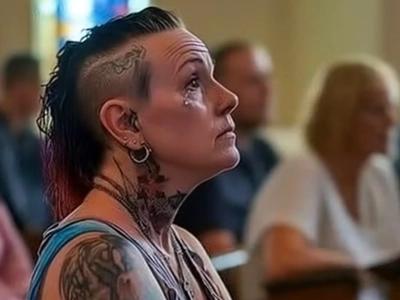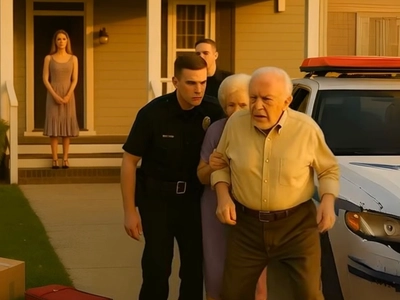In Church, I Noticed An Adult Woman Who Many Tattoos And Body Piercings, And It Made Me Uncomfortable
I grew up thinking church was a place where everyone moved a little softer. Shoes were quieter. Voices dropped. Clothes were simple, clean, and a little plain. That was how my parents raised me, and it stuck. Sunday mornings were for quiet hearts and modest looks. It felt like a way to show respect, a way to say with our bodies what our mouths were about to pray.
Last Sunday, I slid into the same wooden pew I always choose. The sanctuary smelled faintly of old books and candle wax. Sunlight slipped through the stained glass and laid bright colors across the aisle. People were filing in—families I knew, older couples I always wave to, a few new faces. I was in that calm place that comes over me before the music begins, and then the door opened again.
A woman walked in. She looked like she was around forty. Her arms were covered in tattoos—flowers, words, shapes I couldn’t name from where I sat. A dark ink design curled above her collarbone. She had piercings too—ears, nose, a small ring at her lip. She wasn’t dressed immodestly. Her clothes were fine and not flashy. But the art on her skin drew the eye, at least mine, and I felt my stomach clench almost on its own.
I know how this sounds when I write it out, but in the moment it wasn’t some long thought. It was a quick, wordless reaction. I saw her and felt, That doesn’t fit. It felt like seeing a loud painting hung in a quiet hallway. I tried to look away. I told myself to focus on the hymn numbers on the wall, on the cross above the choir, on the bulletin in my hands. Still, my attention kept sliding back toward her like a needle finds north.
When the music started, I sang, but my mind wandered. I wondered what other people were thinking. Were they shocked? Did they feel like I did? Or was I the only one who found her look jarring in this setting? I told myself that God looks at the heart, not the body. I know that. I’ve heard it my whole life. But I also hear that we should be respectful in sacred places. And in my head, the tattoos and the rings felt like a challenge to that. I wish I could say I was better than that first reaction. I wasn’t.
While the pastor preached, I tried to listen, but I drifted. I remembered my mother smoothing my skirt when I was young, saying, “We dress with care for the Lord.” She meant it sweetly, and I took it seriously. For me, the inside and the outside were connected. I didn’t think of this woman as a bad person—not at all. But I felt she had brought too much of the outside into the inside, and I struggled with that.
After the service, we all spilled out into the sunlit courtyard. People stood in clusters, picking up kids, chatting, planning lunch. I got my coffee cup and told myself to go home, mind my business, let it be. I should have done that. But I didn’t. I walked toward her. I told myself I would be polite. I told myself someone should say something because standards matter, and maybe no one had said it yet.
She was standing alone near the edge of the crowd, looking at a brochure rack—youth programs, food pantry, choir schedule. Up close I could see the details on her skin. A small bird on her wrist. A little line of script near her elbow. Her piercings were neat and not big. She looked normal. Human. Just not like the “church look” I grew up with.
“Hi,” I said. “Welcome.” My smile felt tight.
“Hi,” she said. Her smile was small but real.
I took a breath. I tried to sound gentle. “I hope you don’t mind me saying,” I began, “but I think church is a place where we try to be a bit more modest. Your look is… well, it’s a little strong for here. Maybe next time—”
She blinked. The warmth dropped out of her face. “It’s none of your business how I look,” she said. Not loudly. Not rudely. Just firm. Clear. Like a door clicking shut.
I felt my face heat. I stammered something like, “I didn’t mean— I just thought—” She shook her head once, not angry, just done, and turned away. I stood there with my coffee and my confused pride. I felt scolded, but also uncertain. I had wanted to protect the sense of reverence I love. Instead I’d stepped on someone’s toes, maybe on her heart. I went home with that sinking feeling in my chest, not sure if I was right or wrong, only sure that the moment had not gone the way I imagined.
That afternoon I did what people do these days. I wrote about it online. I didn’t use names. I told the story: the tattoos, the piercings, my feeling that church should have a certain standard. I asked if I was being too old-fashioned. I wanted to know if others agreed with me or if they thought I’d missed something. Maybe I wanted reassurance. Maybe I wanted correction. Maybe I wanted both.
The responses started coming in. At first I braced myself for a fight. Internet comments can be harsh. But what I got ran more tender and more challenging than I expected.
One person wrote, “How wonderful she felt comfortable enough to attend church. Acceptance, tolerance, empathy, and compassion are all parts of faith. If her presence unsettled you, look at your heart, not her arms.” Reading that stung, but it also rang. I could almost hear the hymn we sang that morning about the wideness of mercy and wondered if my sense of “modest” had grown narrower than mercy itself.

Another person said, “I was always told we are all God’s children and equal in God’s eyes. Only God can judge. If church is not a place for broken, colorful, wounded, searching people, what is it for?” I thought about the way the sun had painted the aisle, how the colors shifted when the light moved. Maybe the space is already full of color and I was trying to dull it down.
Someone else offered, “Better she is there tattooed up than not there at all. Her style is her own and nobody else’s business.” That line—better there than not there—sat with me. I realized I’ve prayed for people to come, but maybe I had some unspoken rule in my head about how they should look when they arrived. That felt ugly to admit. But it felt true.
Another wrote, “Good on her for showing up. You don’t know her story. You don’t know what those tattoos mean. Maybe it’s loss. Maybe it’s recovery. Maybe it’s art that healed her. Never judge until you’ve walked a mile in her shoes.” I looked back at the small bird on her wrist in my memory and felt a small ache. I had seen a surface and decided it meant something, when in truth it might have meant something else entirely, or many things, or nothing I could name.
There were more. A youth leader shared how the teens in her group come with blue hair, sleeves of ink, thrift store suits, and sneakers that squeak, and how she loves each one of them, not in spite of their looks but with them, as they are. An older man wrote about the years he spent away from God, the guilt on his back like a sack of stones, and how a church welcomed him even when he felt like he didn’t belong anywhere. He said, “They cared more about my tired heart than my rough edges, and that is what saved me.” A woman with three small kids told me she comes to church with Cheerios stuck to her sweater and is grateful nobody turns her away for untidy threads.
Not every message was soft. A few were sharp: “This is exactly the kind of gatekeeping that drives people out.” “If your faith is shaken by nose rings, your faith is too small.” “You embarrassed her.” Those hurt. But dotted between the hard words were patient ones. A pastor wrote, “Standards can be good if they point us toward love, not away from people. Ask yourself which way your words pointed.” A choir member said, “Reverence is an inside thing. It can look like a suit or it can look like a sleeve of ink. Both can be real. Both can be fake. We can’t see the difference from the pew.”
I sat with all of it. I read the thread twice, then three times. I saw the pattern, the same refrain in many voices: It’s not your job to dress other people for worship. It’s your job to bring your own heart to God and to welcome others while they do the same. I turned that over in my mouth like a stone smoothed by water. Welcome. Welcome. Welcome.
I went back to my first impulse. Why did I feel what I felt? Some of it, I realized, was habit. I’m used to church looking a certain way, and when that picture tilts, I try to set it straight. But why does my picture get to be the frame? Some of it was fear, too. Not fear of her, but fear of change, fear of losing the quiet lines that make me feel safe. I don’t think it’s wrong to love quiet and simple things. It becomes wrong when I insist that others must match me before I can call them sister.
I thought about reverence. We sometimes make it a dress code. But I have seen people dressed “right” be cruel, and I have seen people dressed “wrong” weep through a prayer with a tenderness that humbled me. Reverence is a posture of the heart. It can show up in a pressed shirt or a jean jacket. It can show up on skin full of stories. Maybe it is less about what we put on and more about what we put down—our pride, our power, our need to control.
I imagined the woman’s tattoos not as noise but as a language I don’t speak. The little bird on her wrist might remember someone who is gone. The line of script might be a promise she holds onto when the night is long. The ring at her lip might be a small act of joy. Or maybe I am reading into it, and it is simply art she likes. It’s not my task to decode her, or to approve her, or to correct her. My task is to make room on the bench.
The hard part is that I did speak. I already stepped in. I already tried to guide her look with my words, and she pushed back. I keep replaying her face when she said, “It’s none of your business.” There was no hate in it. Just a boundary. If I see her again—and I hope I do—what should I do? Pretend it didn’t happen? Avoid her? That seems cheap. Maybe I can own it. Maybe I can say, “I’m sorry for commenting on your appearance. I was wrong to do that. I hope you felt welcome here.” That feels scary. It also feels like the right kind of small.
One of the last comments I read said, “Standards that protect dignity are good. Standards that shut doors are not. The trick is to keep the first and lose the second.” I like that. It doesn’t tell me to throw away everything I value. It invites me to hold those values in a way that gives others space to breathe. I can still dress simply, speak softly, kneel when I pray. I can also sit next to someone whose life has left marks on her skin and not mistake those marks for disrespect.
Later that evening I went for a walk. The street smelled like cut grass and the sky was turning that nice soft blue. I passed a neighbor I only know by sight. He always wears a band T-shirt and has a dragon tattoo curling out from his sleeve. He waved, and I waved back, and I thought about how easy that gesture is—a small signal that says, I see you and I am not threatened by your difference. Couldn’t that be what church offers too, only warmer, deeper, with coffee and prayer and songs?
If I’m honest, part of me still wants a clear rule. Rules are simple. “No hats.” “No phones.” “Cover shoulders.” But most of the people who wrote to me nudged me away from rules and toward relationship. Talk to her about her week, not her wardrobe. Ask her name, not her reasons for ink. I can see how that is the better path. Relationship is slower and messier than rules. It is also where love actually lives.
The next morning I opened my closet and saw the plain dresses hanging there, the same ones I’ve worn for years. I felt comfort in their quiet fabrics. I will still wear them. They still feel right to me. But I hope I won’t mistake my comfort for a command I can lay on others. If someone comes in with sleeves of roses, with rings that flash when the light hits, I want to greet her without the little flinch inside. Or if the flinch comes, I want to let it pass like a cloud and not turn it into speech. Not everything my mind says needs to become a sentence in the world.
I thought about writing one more post to close the loop. I wanted to tell the people who responded that I heard them. I wanted to thank the ones who were kind and admit to the ones who were sharp that their sharpness cut something in me that probably needed cutting. I wanted to say I will try to be more open next time. Not perfect. Just a little more open.
There is also this: my feeling that church is sacred is real. It matters to me. I don’t need to throw that away to make room for someone else. I just need to remember that a sacred space is not only made of wood and glass and rules. It is made of people. People carry stories on their bodies and in their bodies—scars, lines, freckles, ink, metal, old wounds, new hopes. The room is big enough for all of that. Holiness doesn’t vanish when a nose ring enters a sanctuary. If holiness is worth anything, it holds.
I keep going back to one of the comments that said, “Only God can judge.” I am not sure I ever felt like a judge; I felt more like a hostess trying to enforce house rules. But the house isn’t mine. That’s the piece that humbles me. I am a guest who has been welcomed more times than I deserve. If the host is kind enough to set a place for me, maybe I can trust Him to set a place for the woman with the bird on her wrist without my help.
There is a part of me that wonders if the woman will return. Some people only try church once. One awkward conversation can be enough to send them back out the door. I hope that isn’t true this time. I hope the music drew her in. I hope the words landed somewhere soft. I hope the coffee was hot and the smiles around her were real enough to outweigh my clumsy comment. I don’t get to control that. But I do get to shape what happens if our paths meet again. I can practice a sentence: “Hi, I’m glad you’re here.” I can mean it.
If you’re reading this and you have felt what I felt—that jolt when someone doesn’t fit the picture you hold—maybe you know the tug to correct, to suggest, to point toward some unwritten dress code. I get it. I really do. But maybe the better move is to ask a name and learn a story. Even if you never hear the meaning of the ink, even if you never talk about the piercings, you might find out about a job that is hard, a child who is sick, a mother who is aging, a habit that needs breaking, a joy that needs sharing. That seems closer to the center of what church is for.
And if you are the person with the tattoos and the rings, if you read this and feel tired of being examined every time you walk into a place that says “all are welcome,” I’m sorry for the ways people like me have made you feel small. You don’t owe anyone an explanation for how you look. Your presence is not a problem to solve. You carry your own set of prayers. There is room for you.
By the time the sun went down on Sunday, the sharpness in my chest had softened. I still believe in modesty. I still love quiet. But the idea that those values require me to police someone else’s body has started to loosen its grip. I can hold my preferences and still open my hands to others. I can keep my habits and still make space on the pew.
If you were sitting across from me at my kitchen table right now, I’d pour you coffee and ask what you think. Maybe you’d tell me I was right to speak up. Maybe you’d tell me I crossed a line. Maybe you’d share a story about the time someone met you with grace and how it changed you. I’m learning that most of us don’t need more rules. We need more stories. They teach us how to move in the world without hardening.
So here is where I am, simple and true: last Sunday I saw a woman whose appearance unsettled me. I spoke to her in a way that wasn’t mine to speak. She told me to mind my own business, and she was right. I asked others for their thoughts and heard a chorus that sang about welcome, compassion, and letting God be God. I am trying to learn that song. I won’t sing it perfectly, but I want to sing it better next time.
What do you think?






